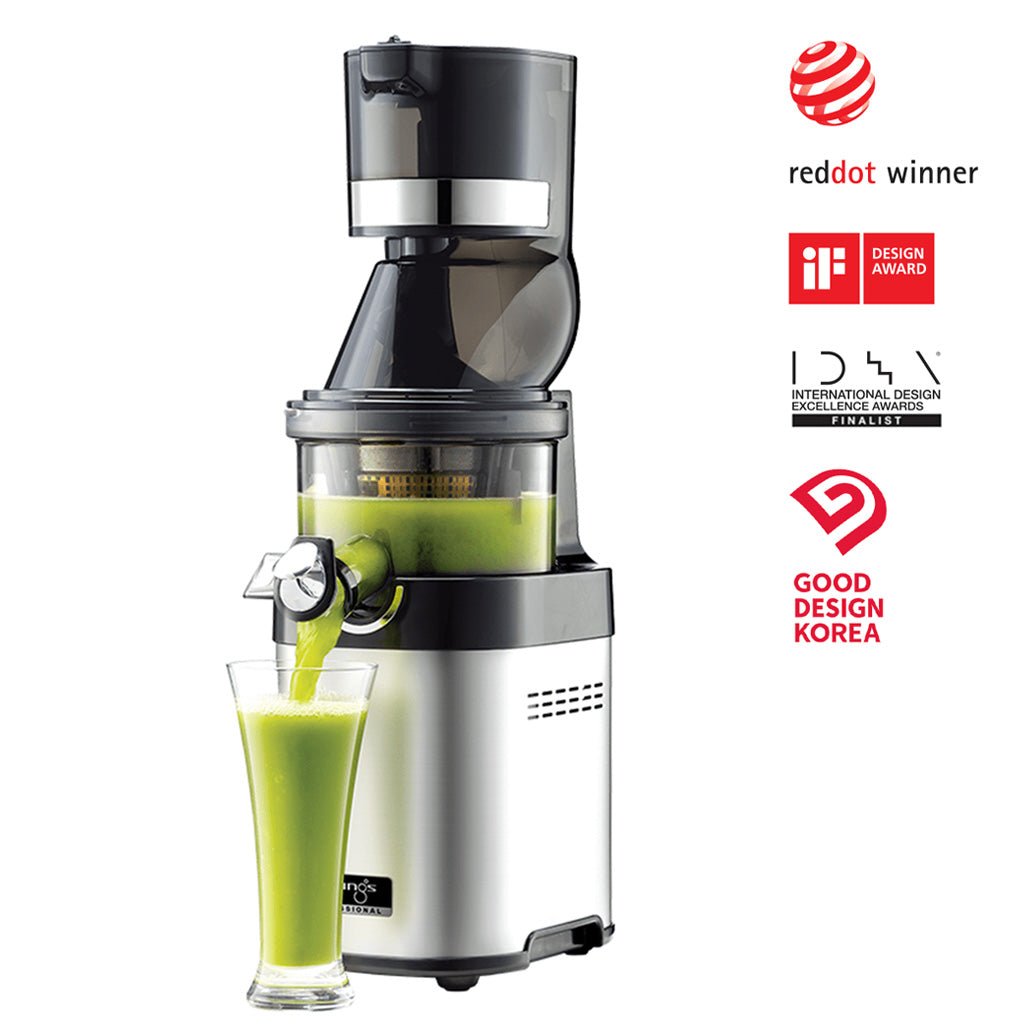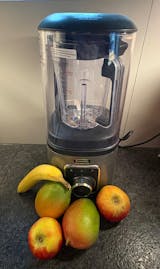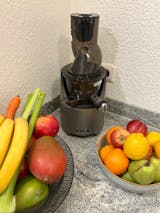Ginger energy shot recipe with Kochchef

This juice recipe aims to boost your energy levels. Ginger promotes circulation, watercress provides a variety of vitamins and minerals for energy production, and grapefruit offers a refreshing boost of antioxidants and vitamin C, which plays a crucial role in energy metabolism by supporting the synthesis of carnitine, a compound that helps the body convert fat into energy.
Regular consumption of this juice can combat fatigue, improve concentration and promote general vitality.
Have fun juicing!

Ingredients:
- 20 g watercress (or arugula as a substitute)
- 5 cm ginger
- 2 pears
- 2 yellow grapefruits
Juicing time : 3 minutes
Amount of juice : 600 ml
Serves : 2
Preparation:
Ginger
- Wash and dry.
- Cut into thumbnail-sized pieces, leaving the skin on.
pears
- Remove the hard stems.
- Juice whole or cut in half if they are too large for the wide feeding chute.
Grapefruits
- Remove the outer shell, keeping as much of the white pith (called the mesocarp) as possible.
- Cut into halves or quarters to fit into the wide feeding chute.
Watercress
- Chop coarsely.
Cold press juicing method
Start with the watercress. Add the entire 20 g to the juicer.
Then add the pears one at a time. They will help press the watercress down and into the press.
Next, juice the grapefruit by cutting it into pieces and pressing each piece through the juicer before adding more.
Finally, add the ginger.

AUTO10S Layering : Watercress, Pear, Grapefruit, Ginger
Tip : You can also make a herbal tea with watercress by pouring boiling water over a handful of the leaves and letting it steep for at least 15 minutes.
Health benefits

Ginger
Ginger is one of the oldest and most popular medicinal spices in the world. It promotes digestion and assimilation and is traditionally used to treat colds, flu, motion sickness, and dizziness.
Ginger has anti-inflammatory, antioxidant, antispasmodic, antiemetic and antibacterial properties – like the favorite aunt among spices.
Especially during the winter months, ginger strengthens the immune system and helps prevent colds. The gingerols it contains rapidly and noticeably dilate blood vessels, promote blood circulation, and lower blood pressure.
Additionally, ginger contains its own form of vitamin C and helps the body respond better during illness.

Pear
Pears are in season in the fall and help provide much-needed moisture to our lungs, parched by the summer heat. They suppress the appetite and strengthen the stomach, preventing overeating at meals.
Pears are often overlooked in favor of apples when juicing on a daily basis, but just like apples, they are one of the most important foods you can eat.
Pears help rejuvenate the pancreas – an organ that is often overlooked but plays an essential role in converting food into energy for the body's cells.
Pear juice is rich in electrolytes, which can stabilize blood sugar levels. Pears are also low in calories, making them ideal for weight loss.
I highly recommend adding pears to your juice supply.
Tip: If a pear is hard and crunchy, it's easier to juice and has a higher fiber content. If a pear is soft, it has a higher glucose content. It's then very easy to digest and easier to eat or blend into a smoothie.

Yellow grapefruit
Yellow grapefruits are rich in vitamin C, which is important for immune function, collagen synthesis, and wound healing. Consuming foods rich in vitamin C may help reduce the duration and severity of colds and improve overall immune function.
Yellow grapefruits contain various antioxidants such as beta-carotene, flavonoids, and lycopene. These compounds help neutralize harmful free radicals in the body, reduce oxidative stress, and lower the risk of chronic diseases such as heart disease and cancer.
Like other citrus fruits, yellow grapefruits have a high water content, making them hydrating and refreshing. Adequate hydration is essential for overall health, as it supports various bodily functions such as temperature regulation, nutrient transport, and waste elimination.
Finally, yellow grapefruits are a good source of potassium, an electrolyte that helps regulate blood pressure and maintain proper muscle and nerve function.

Watercress
Despite its humble appearance, watercress is a true powerhouse of nutrients. It's rich in vitamins A, C, and K, as well as various B vitamins. Watercress also contains iron, calcium, and magnesium, which are important for energy production. It's also rich in phytonutrients like sulforaphane, which can help combat fatigue and improve overall vitality.
Watercress's high vitamin K content plays a crucial role in bone metabolism and calcium absorption. Adequate vitamin K intake can help reduce the risk of osteoporosis and improve bone density.
It also contains a high level of iodine, which is beneficial for both the thyroid and the immune system. Watercress also has antibiotic properties similar to those of onions, giving it a spicy flavor and a special kick.





![[ The New York Times ] Kuvings Entsafter - Eine Investition in die Gesundheit - Kuvings Deutschland](http://kuvings.de/cdn/shop/articles/the-new-york-times-kuvings-entsafter-eine-investition-in-die-gesundheit-5051352.jpg?v=1763482421&width=1080)
![[ Kuvings ausgezeichnet ] Präsidentenauszeichnung für regionale Innovation in Südkorea - Kuvings Deutschland](http://kuvings.de/cdn/shop/articles/kuvings-ausgezeichnet-prasidentenauszeichnung-fur-regionale-innovation-in-sudkorea-1602687.jpg?v=1762447229&width=1080)
![[ Kuvings x SV Werder Bremen ] Ein Tag voller gesunder Energie - Kuvings Deutschland](http://kuvings.de/cdn/shop/articles/kuvings-x-sv-werder-bremen-ein-tag-voller-gesunder-energie-5645597.jpg?v=1761784399&width=1080)









